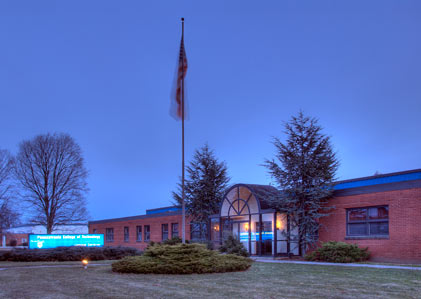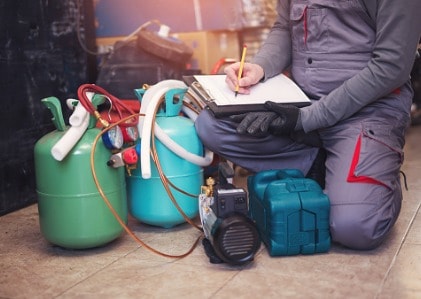Extreme Weather Events and the Demand for HVAC Workers
According to the Bureau of Labor Statistics (BLS 2018), the number of HVAC positions in the United States is expected +to grow at 15 percent between 2016 and 2026—more than twice the national average for all jobs. This is a profession that bends to microtrends in geography and weather patterns, and it has been a turbulent time for several states experiencing record-breaking extremes of both cold and heat. This year saw temperatures drop so dangerously low across the United States that Niagara Falls almost froze, and less than seven months later, heat records were set all over the world.
Several states are outpacing the national average for growth in the HVAC sector, and with good reason: efficient and stable climate control is no longer a luxury, and in some cases, it can be a matter of life and death. And while there’s a global climate change occurring on a macro-scale, the more immediate fluctuations on the micro-scale can be just as dire to those they affect.
Read on to learn about how extreme weather events in the following ten states have led to an increased demand for HVAC workers.
California
California likes to pretend it is not built upon a desert, while nature likes to remind its citizens that it is. All-time records for extreme heat in the state were topped yet again in 2018, and the future weather forecast suggests extreme weather should be considered a new normal here. From the bustling construction sites of San Diego, to the sweating summer megapolis of Los Angeles, to the desert landscape of the San Fernando Valley, Southern California needs HVAC as much as it needs rain.
Northern California hubs like Sacramento, with its 14 hours a day of July sunshine, and San Francisco, perhaps at the head of the pack for smart-building design, both chip in to make the state the second largest employer of HVAC professionals in the nation. According to state data on Projections Central, the number of HVAC positions is still expected to increase by almost 20 percent in the decade preceding 2026.
Nevada
Nevada consists mostly of long plains, with splashes of mountain and desert, but experiences extreme variance in weather from season to season. The summer will heat up well over 100 degrees, while the winter nights can dip below freezing.
The majority of Las Vegas is climate-controlled year-round, and HVAC professionals are increasingly needed to update, maintain, replace, and install new functionalities throughout the city. Due to its extreme climate swings, Nevada has one of the fastest growing needs for HVAC professionals, with state data from Projections Central forecasting a growth of more than 30 percent (2016-2026).
Texas
Texas is the largest state in the country, and one of the hottest. In 2011, Dallas had a record number of 100-degree days—71 to be exact—when the average in the previous three decades had been 18 days. Houston has been called one of the most air-conditioned cities in the world. Year-round heat in San Antonio and a booming economy in Austin make Texas an HVAC hub that’s likely to grow even more.
This is a state that scorches in the summer, and HVAC installations and repair can save lives. Even with Texas’s high number of working HVAC professionals (it employs the third most in the nation), Projections Central data suggests the state will add more than 6,000 more by 2026.
Arizona
Arizona is particularly prone to extreme weather events. This is a state with some areas exposed to over 126 days of triple-digit temperatures in the summer, while winter months can drop below freezing and be accompanied by snowstorms. Proper HVAC is not just a convenience in Arizona; it is a matter of public health.
It is no surprise that the Phoenix metropolitan area, when combined with Mesa and Scottsdale, has one of the highest levels of HVAC employment in the U.S., and the number of HVAC positions in the state is expected to increase by over 40 percent (2016-2026), according to state data by Projections Central.
New York
From blizzards to heat waves, New Yorkers are used to dealing with extremes, but the weather has been getting more extreme every year. Even the average swing in temperature is drastic—upstate, Rochester’s average low temperature in January is 18 degrees Fahrenheit, while the average high in July is 81 degrees Fahrenheit.
With the state-mandated Warranty of Habitability ensuring property owners properly heat and cool their tenants’ homes, it makes sense that HVAC services are in high demand here. New York City employs more than 12,000 HVAC professionals—almost twice as many as the second largest such city—and state data on Projections Central suggests that New York will add 2,700 more HVAC jobs between 2016 and 2026.
New Jersey
This year, the Winter Bomb Cyclone dropped temperatures in the low teens in New Jersey, followed by the state experiencing schizophrenically high temperatures that set new records for February. While the swings have been the most drastic as of late, they are not an entirely new scenario for New Jersey, a state that already employs almost 10,000 HVAC professionals.
Drastic swings may be more normal in the future, and the state is preparing itself. Data from Projections Central suggests that New Jersey will grow its HVAC industry by almost 18 percent (2016-2026).
Colorado
Consisting of mountains and plains, Colorado is host to a variety of microclimates that each have unique heating and cooling needs. But recently it has been experiencing much more variance than usual. In February 2018, Denver had its coldest day in more than a century. Just four months later, the city matched its hottest day ever, with similarly blistering temperatures tying or breaking records in Akron and Boulder.
Northwest Colorado is one of the highest paying non-metropolitan areas in the U.S. for HVAC professionals, and other parts of the state may soon follow suit. According to Projections Central data, Colorado is expected to add over 2,000 HVAC jobs in the decade following 2016, growing by the industry there by 38.3 percent.
Florida
Out of all 50 states, Florida is projected to see the biggest increase in extreme heat over the next few decades, with more than half a million people at risk. Most of the 20 million people in the Orlando area thrive on climate control.
Construction projects in Jacksonville, Daytona Beach, and Miami—combined with a predictably hot and humid climate, a growing economy, and financial incentives for energy efficiency—make Florida a leader in the field; they employ more HVAC professionals than any other state. Even so, data suggests that number will increase by 26.8 percent (2016-2026), with Florida adding almost 9,000 new HVAC positions in that timeframe.
Utah
In a heat wave that would set up the state’s worst drought in over 50 years, 2012 saw 40 high-temperature records fall in Utah. The very next year, parts of Southern Utah saw their coldest temperatures in living memory. These factors could contribute to the recent surge Utah is seeing in the HVAC profession.
While the state only employes 3,550 HVAC professionals at the current time, data according to Projections Central suggests that the number of HVAC positions in the state will grow by over 42 percent between 2016 and 2026.
Michigan
In what residents would have hoped was a late April Fool’s joke, Michigan hit its lowest monthly temperature in almost a century this year at minus 23 degrees Fahrenheit. It would have been cold even for the depths of a Michiganian winter, but for the second week of April, it was almost without precedent.
The lower peninsula of Michigan has inversely seen a steady rise in summer temperatures since the late 1980s, so much so that the warming has put the state in danger of violating the Clean Air Act due to “excessive ozone action days,” according to a policy director at the Michigan Environmental Council.
More energy efficient HVAC could play a part in resolving that, which is perhaps why data according to Projections Central suggests Michigan will add over 1,200 new HVAC positions in the decade following 2016, leading to an increase of over 13 percent.



